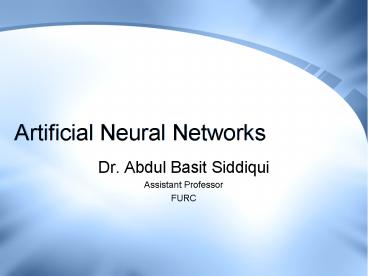Artificial Neural Networks - PowerPoint PPT Presentation
Title:
Artificial Neural Networks
Description:
NEURAL NETWORKS BASED ON COMPETITION Kohonen SOM ... Architecture of SOM Kohonen SOM (Self Organizing Maps) Structure of Neighborhoods Kohonen SOM ... – PowerPoint PPT presentation
Number of Views:459
Avg rating:3.0/5.0
Title: Artificial Neural Networks
1
Artificial Neural Networks
- Dr. Abdul Basit Siddiqui
- Assistant Professor
- FURC
2
Neural Networks based on Competition
- Kohonen SOM (Learning Unsupervised Environment)
3
Unsupervised Learning
- We can include additional structure in the
network so that the net is forced to make a
decision as to which one unit will respond. - The mechanism by which it is achieved is called
competition. - It can be used in unsupervised learning.
- A common use for unsupervised learning is
clustering based neural networks.
4
Unsupervised Learning
- In a clustering net, there are as many units as
the input vector has components. - Every output unit represents a cluster and the
number of output units limit the number of
clusters. - During the training, the network finds the best
matching output unit to the input vector. - The weight vector of the winner is then updated
according to learning algorithm.
5
Kohonen Learning
- A variety of nets use Kohonen Learning
- New weight vector is the linear combination of
old weight vector and the current input vector. - The weight update for cluster unit (output unit)
j can be calculated as - the learning rate alpha decreases as the learning
process proceeds.
6
Kohonen SOM (Self Organizing Maps)
- Since it is unsupervised environment, so the name
is Self Organizing Maps. - Self Organizing NNs are also called Topology
Preserving Maps which leads to the idea of
neighborhood of the clustering unit. - During the self-organizing process, the weight
vectors of winning unit and its neighbors are
updated.
7
Kohonen SOM (Self Organizing Maps)
- Normally, Euclidean distance measure is used to
find the cluster unit whose weight vector matches
most closely to the input vector. - For a linear array of cluster units, the
neighborhood of radius R around cluster unit J
consists of all units j such that
8
Kohonen SOM (Self Organizing Maps)
- Architecture of SOM
9
Kohonen SOM (Self Organizing Maps)
- Structure of Neighborhoods
10
Kohonen SOM (Self Organizing Maps)
- Structure of Neighborhoods
11
Kohonen SOM (Self Organizing Maps)
- Structure of Neighborhoods
12
Kohonen SOM (Self Organizing Maps)
- Neighborhoods do not wrap around from one side of
the grid to other side which means missing units
are simply ignored. - Algorithm
13
Kohonen SOM (Self Organizing Maps)
- Algorithm
- Radius and learning rates may be decreased after
each epoch. - Learning rate decrease may be either linear or
geometric.
14
KOHONEN SELF ORGANIZING MAPS
Architecture
neuron i
Kohonen layer
wi
Winning neuron
Input vector X
Xx1,x2,xn ? Rn wiwi1,wi2,,win ? Rn
15
Kohonen SOM (Self Organizing Maps)
- Example
16
Kohonen SOM (Self Organizing Maps)
17
Kohonen SOM (Self Organizing Maps)

















![Introduction to Artificial Neuron Networks [ANN] PowerPoint PPT Presentation](https://s3.amazonaws.com/images.powershow.com/6292342.th0.jpg?_=20150319091)













